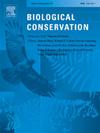怎样才能生存?一种专家启发的方法来理解火灾发生和持续的驱动因素
IF 4.9
1区 环境科学与生态学
Q1 BIODIVERSITY CONSERVATION
引用次数: 0
摘要
火灾是全球重要的生态系统过程。然而,气候变化正在加剧火灾状况,从而对景观格局的许多方面产生重大影响。避难所,即火灾中未被烧毁的区域,对于物种在火灾期间的生存和火灾后的恢复都很重要。了解火灾避难所的当代模式对于当前的火灾风险管理和长期保护规划非常重要。在这项研究中,我们限定了澳大利亚东南部火灾避难所的模式,以更好地为火灾风险管理提供信息。我们使用定性专家启发方法来确定三个案例研究区域的土地和火灾管理人员的变量,这些变量被认为是火灾避难所的关键驱动因素。我们还从专家那里得到了这些关键驱动因素与火灾避难所在极端和良性火灾天气条件下持续存在的可能性之间的关系。由于自上而下的地形对植被结构和组成以及湿度的影响,人们认为火灾避难所在空间上受到限制。持久防火避难所是那些在最极端的火灾天气条件下保持这些湿度梯度的避难所。临时避难所没有任何独特的环境条件,它们与持久避难所不同,因为它们并不总是在极端的火灾条件下持续存在。火灾天气在决定火灾避难所方面起着主导作用,突出了在预测的气候变化下维护这些地点的挑战。专家知识增加了识别和绘制火灾避难所的可用方法的工具包,例如遥感方法。本文章由计算机程序翻译,如有差异,请以英文原文为准。
What does it take to survive? An expert elicitation approach to understanding the drivers of fire Refugia occurrence and persistence
Fire is an important ecosystem process globally. However, climate change is intensifying fire regimes resulting in high impacts on many aspects of landscape patterns. Refugia, or unburnt areas within fires, are important for species survival during fire and for recovery after a fire. Understanding the contemporary patterns of fire refugia is important for current fire risk management and long-term conservation planning. In this study we qualify the patterns of fire refugia in southeastern Australia to better inform fire risk management. We use qualitative expert elicitation approaches to identify the variables that land, and fire managers across three case study regions deemed to be the key drivers of fire refugia. We also elicited from experts the relationships between these key drivers and the probability of fire refugia persisting under extreme and benign fire weather conditions. Fire refugia were thought to be restricted spatially due to top-down topographic influences on vegetation structure and composition, as well as moisture. Persistent fire refugia are those which maintain these moisture gradients in the most extreme fire weather conditions. Ephemeral refugia do not have any unique environmental conditions, they differ from persistent refugia as they do not always persist in extreme fire conditions. Fire weather has a dominant role in determining fire refugia, highlighting the challenges of maintaining these sites under predicted climate change. Expert knowledge adds to the tool kit of approaches available for identifying and mapping fire refugia, such as remote sensing approaches.
求助全文
通过发布文献求助,成功后即可免费获取论文全文。
去求助
来源期刊

Biological Conservation
环境科学-环境科学
CiteScore
10.20
自引率
3.40%
发文量
295
审稿时长
61 days
期刊介绍:
Biological Conservation is an international leading journal in the discipline of conservation biology. The journal publishes articles spanning a diverse range of fields that contribute to the biological, sociological, and economic dimensions of conservation and natural resource management. The primary aim of Biological Conservation is the publication of high-quality papers that advance the science and practice of conservation, or which demonstrate the application of conservation principles for natural resource management and policy. Therefore it will be of interest to a broad international readership.
 求助内容:
求助内容: 应助结果提醒方式:
应助结果提醒方式:


